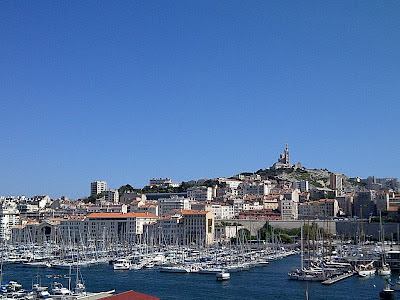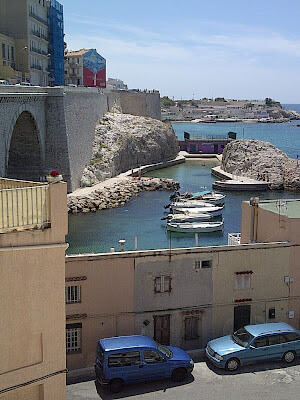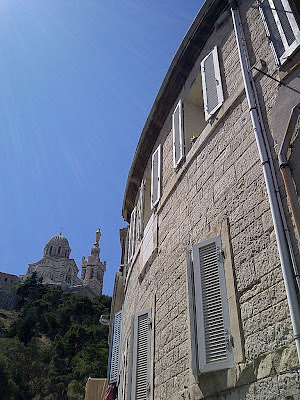Three days in Marseille isn't long enough. Well, three days is long enough to make a person fall in love with the city and want to move there. It is definitely not long enough, however, to understand the city's unique character and complexity - from the hectic, buzzing work hard, play hard ethos of its inhabitants, to the laid back glamour meets ethnic underworld of its architecture and nightlife...
On my recent visit to the city I found that tourists and locals gathered together haphazardly at almost every bar and restaurant in the old port and beyond, making it difficult to differentiate proprietors offering a watering hole for cruise passengers, from those providing a posing ground for local teenagers, and then from those who cared about serving fresh, tasty food and good wine. The old city of Marseille has a feeling of everything being thrown in together: different cultures, history, commerce, tourists, industry, tradition. It is noisy, busy, a little crazy in parts and then eerily still and chilled out in others. Look one way on the old harbour and you see local fishermen selling fresh fish from a makeshift pop-up market stall; look the other and you see fast food restaurants and shopping streets to rival Paris' boulevards. Gaze out to sea from the restaurants lining the old port and ancient fortresses flank the port's entrance, overshadowed by the glistening gold statue of the Notre-Dame de la Garde. Wander around the corner and you're faced with France's largest commercial port and impressive views of huge liners coming and going every half an hour or so. You get where I'm going with this, I'm sure. The contrast is staggering and set to be made even more apparent by the major developments currently underway to prepare Marseille for its status as European Capital of Culture in 2013. The contrast between old and new, tradition and progression, is what makes the city so attractive and intriguing. It is vibrant, fascinating, addictive and, above all, so unexpectedly beautiful that you never want to leave.
On my recent visit to the city I found that tourists and locals gathered together haphazardly at almost every bar and restaurant in the old port and beyond, making it difficult to differentiate proprietors offering a watering hole for cruise passengers, from those providing a posing ground for local teenagers, and then from those who cared about serving fresh, tasty food and good wine. The old city of Marseille has a feeling of everything being thrown in together: different cultures, history, commerce, tourists, industry, tradition. It is noisy, busy, a little crazy in parts and then eerily still and chilled out in others. Look one way on the old harbour and you see local fishermen selling fresh fish from a makeshift pop-up market stall; look the other and you see fast food restaurants and shopping streets to rival Paris' boulevards. Gaze out to sea from the restaurants lining the old port and ancient fortresses flank the port's entrance, overshadowed by the glistening gold statue of the Notre-Dame de la Garde. Wander around the corner and you're faced with France's largest commercial port and impressive views of huge liners coming and going every half an hour or so. You get where I'm going with this, I'm sure. The contrast is staggering and set to be made even more apparent by the major developments currently underway to prepare Marseille for its status as European Capital of Culture in 2013. The contrast between old and new, tradition and progression, is what makes the city so attractive and intriguing. It is vibrant, fascinating, addictive and, above all, so unexpectedly beautiful that you never want to leave.
It can be overwhelming. If staying in the centre of Marseille, ease into the bustle by taking a lazy breakfast at one of the restaurants lining the Vieux-Port, admire the expensive boats bobbing in the harbour, and amble past the beautiful old buildings and ancient forts guarding the entrance to the city. Take a few steps away from the old port and discover the main square of bars and restaurants, busy and sun-drenched from dawn 'til dusk, or, on the other side of the port, the old town (Le Panier) a close-knit inner city community made up of narrow, pedestrianised streets and quirky bars, with criss-crossing washing lines and colourful flags hung between ancient apartment buildings. Be prepared to dodge hordes of kids on scooters and playing rowdy games of football if you want to discover the shady but bare concrete squares between crumbling apartment blocks. Follow the tourist trail, painted in faded red on the pavement, through alleys, up old stone steps, and suddenly emerge from the darkness to a bright, glorious glimpse of the azure blue waters of the port and sit on marble benches soaking up the early evening sun (like the locals do).
To escape the constant traffic and bustle of the streets surrounding the old port, fix your eyes up high on the gleaming gold statue of the Notre-Dame de la Garde and follow the crowds of tourists to the highest point in the city. To avoid a long steep walk in beating sunshine, the sightseeing bus tour is a fantastic way to explore Marseille for the first time. Not only does it allow you to zip along the coastal road with azure blue sea views and a light breeze through your hair, the bus effortlessly winds its way through some of the most beautiful residential areas in the city and suddenly emerges at the top of the world. Here, where you can't quite believe your eyes as you take in the views from the Notre Dame de la Garde over the entire city, slums, mansions, the sandy coast, clear blue sea, tiny islands and the ancient and infamous Chateau d'If, is the place to start feeling like you know a little more about this sprawling, contrasting Mediterranean city.



